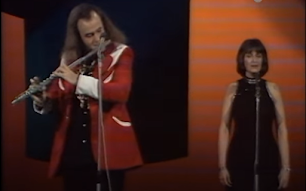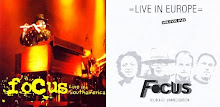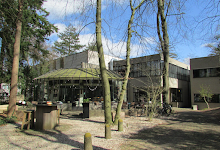
At first blush the subject looks thin. The man’s a guitarist not a singer and his output has been very much in the area of the instrumental. Unlike Clapton and others whose voices are as famous as their guitars, Jan is strictly an axeman. Or should we say almost.
I was slightly taken aback at the opening title track on his live
Ten Thousand Clowns. Could that be Jan? While not exactly singing, it was certainly a vocal. Then we recalled the same uncredited style on the haunting
Wallenberg (From the Basement). Apparently it may be Jan on other tracks too (
PCB Chicken and
Dark Rose). Jan also confesses to singing on the cold war pop song
The Russian spy and I, a Dutch number one for the Hunters at the end of the sixties (The Russian spy and I, we both wonder why, the world is split in two). Other Hunters material also features Jan. As he put it, this was before the hormones really kicked in! (See Youtube for evidence). Persistent rumours suggest that he sings on
I need a bathroom (Mother Focus) and (with van Leer) on
O Avondrood prepared for patriotic Dutch 1976 compilation,
Zing je Moorstaal. (
O Avondrood is a setting of a Dutch poem. Its staccato lines read, O evening glow, glow of flames, O massacre in the west, O late rose, Empty box, O mortal remains, etc).
That leads us to another category where a vocal element comes in, or rather, goes out.
O Avondrood is best known without the vocal as
Red sky at night (Ship of Memories). A few other titles in the repertoire have lyrics but have been recorded as instrumentals. On the first solo album,
Guitar for Sale, we find versions of Bobby Gentry’s
Ode to Billy Joe (And then she said I got some news this morning, From Choctaw Ridge, Today Billy Joe MacAllister, Jumped off the Tallahatchie Bridge), Ray Charles’
What’d I say (Make me feel so good, make me feel so good right now … Mmm, see the girl with the red dress on, She can do the dog all night long, All right, hmm what’d I say, tell me what’d I say, Tell me what’d I say, tell me what’d I say right now) plus
Comin’ home baby and
Mercy, mercy, mercy.
Ode to Billy Joe was originally recorded for Conny van Begen to sing over.
Hineimatov is usually sung with Psalm 133 (Behold how good and how pleasant it is for brothers to dwell peacefully together). A similar feature is found on later albums -
Focus in Time’s Coco Montaya piece
Am I losing you (I wanna know where I stand, Am I in, am I out of your plans? I wanna know what to do. Am I losing you?) and the Jacques Brel song
Mon Amour (Passion). Autumn Leaves (Live at the Priory) was given lyrics at some point (The falling leaves drift by my window, The autumn leaves of red and gold, I see your lips, the summer kisses, The sun-burned hands I used to hold, Since you went away the days grow long, And soon I’ll hear old winter’s song, But I miss you most of all my darling, When autumn leaves start to fall).
There are plenty of straightforward vocal numbers, chiefly where Jan is working as part of a group. With the Hunters (and just before that on Lennon McCartney numbers, etc) there were plenty of vocal tracks (Bob Dylan, etc). The 1969
Brainbox LP featured vocals on more than half the album - tracks such as Tim Hardin’s
Reason to believe, Scarborough Fair (a traditional revived by Simon and Garfunkel), Gershwin’s
Summertime, Lowell Fulson’s
Sinners’ Prayer (a Harry Belafonte hit) and group compositions. With
Focus, the first album (
In and Out of) features four vocals. After this, though the band was chiefly instrumental, at least one vocal featured on practically every album. Voices and minimalist vocal efforts also feature.
The
Brainbox vocalist was Kaz Lux. Jan went on to record
Eli (1976) and
Transparental (1984) with him. Both feature large doses of vocal (
Eli, Guardian Angel, Can’t fake a good time, There he still goes, Strindberg, Naked actress and nearly all the tracks on
Transparental). The lyrics are generally of a philosophical sort, featuring (on
Eli) snatches from the life of the eponymous hero (The spoken line from Strindberg stands out: Hey, August, I never could see the connection between the hammer and the nail, but now I know they both get hurt). The
Eli album originally came with a sheet containing more lyrics than songs.
In the 1980s Jan was with heavy rock band
Forcefield for a couple of albums. Several tracks have vocals including versions of Cliff Richard’s
Carrie and a segued
Black Night/Strange Kind of Woman. As for the solo albums, we have mentioned
From the Basement which also features Dino Walcott on a reggae version of
All along the Watchtower (made famous by Hendrix but written by Dylan). The album was re-released a few years ago with bonus tracks featuring impromptu vocals from Freddy Cavalli. It is not unknown for Jan to use a vocalist for a number in live concerts from time to time. His session work has also often involved him in backing vocalists. One other album with a vocal element is the unique transatlantic album
Jan Akkerman 3, including Willie Dee’s
She’s so divine (got me reeling like a fish on the end of the line) and Yvette Cason’s
Funk me.
An intriguing question is whether words pass through the man’s head as he writes and plays. Certainly with a track like
Wake up (Blues Hearts) it is difficult not to hear those very words echoing the guitar. Can we detect it too on, say,
Just because (Heartware; Can’t stand noise) – something on the lines of ‘It’s not your eyes, it’s not your hair, it’s not the way you smile … I love you, babe, just because (that’s why I love you) I love you, babe, just because …’. Or
Quiet Storm ‘Quiet storm – middl’ of the night. Quiet storm – is it wrong, is it right? Quiet storm – it’s just outta sight. A quiet storm, a quiet storm, quiet storm. I love you, you know its true, I need you, I need you so ….’ Am I the only one with words running through his head? According to Jan it is images that go through the mind rather than words but perhaps someone has penned some wonderful lyrics to
Love Remembered or
May be just a dream. Can someone adequately supply the first half to the line ending ‘… the House of the King’? (See below).
PS On certain versions of the album Heartware you can find a track called Luxemburger where Jan sings a version of
Got my Mojo working. The original version of
Fresh Air on
Profile originally included lyrics sung by Cyriel Havermans but they had to be removed.
Peet Johnson reveals that lyrics were written for House of the King by Mike Hayes. These are the source of the title. They can be found in his book on Focus. They begin
In the house of the king of kings,
A man can find many things.
Drink a golden goblet full of wine,
Made from fruit from a godly vine,
A nectar tasting so divine,
and ends
In the house of the king of all kings,
Sits a wise one who knows these things,
He continues to dine,
Still keeps on drinking the wine,
He likes it just fine,
In the house of the king of all kings



























